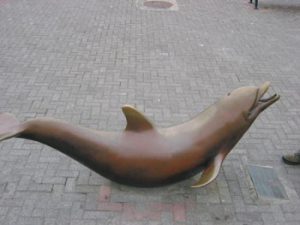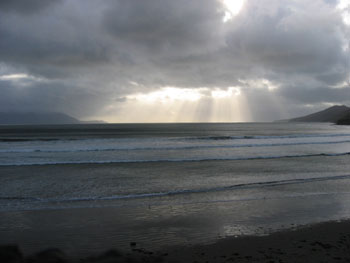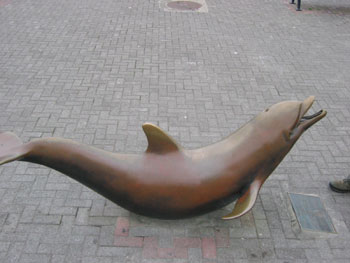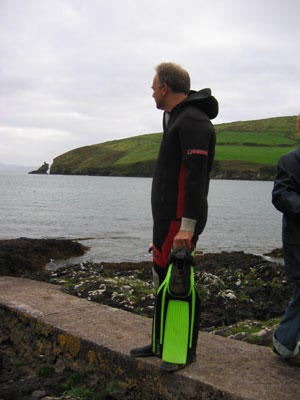
This week’s episode features a personal essay about my experiences of swimming with Fungie – the famous solitary dolphin who has been living near the town of Dingle on the west coast of Ireland. Stay tuned for future episodes about lone, sociable dolphins and the whale and dolphin watching industry featured this month on The Dolphin Pod.
For almost any remote village in the rural expanse of western Ireland, an extended visit by celebrities like Tom Cruise and Nicole Kidman would be cause for excitement and celebration – a guarantee of immediate media coverage that, handled properly, could become a tourist industry cash cow for the local community. But for the town of Dingle in Ireland’s westernmost county of Kerry, a visit by Tom and Nicole in 1991 while filming the Hollywood blockbuster Far and Away hardly raised an eyebrow among the locals. Dingle had found its cash cow seven years earlier, in 1984, in the form of Fungie, an Atlantic bottlenose dolphin that would become an Irish celebrity of the highest caliber. In the almost 20 years since he first took residence in Dingle harbor, tens of thousands of people have come to Dingle to be in the presence of this famous dolphin. I, like many before me, had come to Dingle in 2005 to see Fungie with my own eyes. – This was something Tom Cruise did during his visit to Dingle over a decade earlier. Unlike Tom who watched Fungie frolic in the turbid waters of Dingle bay from the comfort of his private helicopter, I was to view Fungie while submerged in the cold embrace of the Atlantic. I came to swim with Fungie.
For reasons I am incapable of articulating, sighting dolphins and whales in the open ocean has always caused me to go slightly giddy. It came as no surprise to old friends when I announced in my late twenties that my newest career choice would see me conducting research on dolphin communication as part of a university degree. My good fortune has allowed me to enter the water with a variety of wild dolphin species across the globe from The Bahamas to Japan. Although I was living in Ireland at the time, I somehow managed to miss every opportunity to swim with perhaps the most famous of wild dolphins. So, I came to Dingle in the autumn of 2005 to rectify this oversight. I accompanied my friend Tim Ecott, a writer working on a book about dolphins, as he plunged deep into the Fungie phenomenon through a series of interviews with local dolphin lovers. Tim made contact with Graham Timmins, the man behind irishdolphins.com, and someone who we quickly learned was a full-blown Fungie historian. We shared a cup of tea in the garden-hugged house that Graham renovated; it was close to Ventrey bay and he’d lived there for about two decades. Under an expanse of grape vines running along the ceiling of Graham’s conservatory, we probed him for information about Fungie, the local community, and the nature of the eccentric people who swarmed to Dingle to swim with this famous dolphin.
For some time in the early 90’s, Graham was what he called ‘the flavor of the month‘ in the eyes of Fungie. Back then, when swimming with the dolphin was more popular, Fungie had a history of choosing a select few individuals from the throngs of swimmers as his favorites. He turned his attention exclusively in their direction. These favorite few usually fell by the wayside as Fungie’s tastes changed unpredictably; Graham had not received much personal attention from Fungie in over a decade. Fungie, according to Graham, only had eyes for motorboats these days. Tim and I hoped this was not true as we headed toward the pier to prepare for our plunge into the bay.
 The spectacle of a wild dolphin seeking the company of earth-bound humans is truly a rare occurrence. Scientists have compiled a list of around 30 such dolphins over the last few centuries. These ‘solitary, sociable dolphins‘, the vast majority of which are bottlenose dolphins, actively seek the company of humans and boaters for reasons that remain a mystery to the scientific world. The proper management of both dolphins and swimmers in these situations is hotly debated by marine mammalogists, conservation groups, and dolphin swim enthusiasts. No matter where these dolphins appear, from Ireland to Australia, it is a guarantee that humans will be drawn to them.
The spectacle of a wild dolphin seeking the company of earth-bound humans is truly a rare occurrence. Scientists have compiled a list of around 30 such dolphins over the last few centuries. These ‘solitary, sociable dolphins‘, the vast majority of which are bottlenose dolphins, actively seek the company of humans and boaters for reasons that remain a mystery to the scientific world. The proper management of both dolphins and swimmers in these situations is hotly debated by marine mammalogists, conservation groups, and dolphin swim enthusiasts. No matter where these dolphins appear, from Ireland to Australia, it is a guarantee that humans will be drawn to them.
We met Nick and Suzanne, recent residents to Dingle and regular swimmers with Fungie, in a field not far from our point of water entry. This was to be their inaugural swim of the season; their enthusiasm was clear as we shouldered our gear bags and trekked down the well-trodden cow path toward the bay. My first glimpse of Fungie was from the beach and confirms what I noticed in the postcards prominently displayed the shop windows throughout the town: Fungie is an unusually large and exceptionally fat dolphin. He certainly has not missed many, if any, meals.
There was a collection of expectant onlookers huddled under rain jackets and wool hats along the beach. Some were simply passing by and stopped to investigate the commotion; some watch wide-eyed and envious, wishing they were the ones bobbing in the waves hoping to encounter Fungie face-to-face for the first time. And, some were former swimmers like Graham who had fallen out of favor with Fungie and came to the beach reluctantly, hesitant to rekindle fond but painful memories of their unique encounters with Fungie. We entered the water excitedly; the chill coming as a shock to my system. The sight of Fungie just a few meters away squashed any reluctance I had. Almost immediately, Fungie retreated in the direction of several smaller boats in the harbor without allowing much of a glimpse. We began the optimistic wait for his return.
I kicked my fins in regular beats trying to avoid cramps that threatened to hijack my legs as the cold water bathed my skin. My wetsuit was comically large and the freezing seawater flushed continuously around my chest with each passing wave. For a dolphin of Fungie’s considerable girth, these experiences must be wholly foreign – a thick layer of blubber between his skin and the muscle underneath will keep him toasty and warm in the frigid Irish winter. As we bobbed like corks in Dingle bay, Fungie was in the distance playing in the wake of a dozen or so boats. He appeared indifferent to the presence of the swimmers lurking in his territory – just as Graham predicted, ‘Fungus’, as the regular swimmers affectionately called him, was completely charmed by the motorized boats with their sizeable wakes. Despite our best efforts to make ourselves attractive to the dolphin – Nick whistling 60’s television theme songs, Tim making silly dolphin sounds in his snorkel, I clapping my hands under water – Fungie never swam in our direction. We were left alone in the water, bobbing sorrowfully in our non-mechanized vigil. Nick and Suzanne admitted defeat 60 minutes into our swim; I was not sorry to return to the beach with them. The cold left me uninterested in dolphin attention – all I could focus on was the prospect of warm tea and dry socks. Tim was more reluctant to admit defeat. He remained in the bay kicking and splashing, trying to get Fungie’s attention as the boats brought him tantalizingly close, but never close enough. When Tim finally joined the rest of us on shore, we officially called the expedition to a close. Fungie snubbed us as predicted. Graham proved himself a keen and accurate observer – a man who knew the dingle dolphin as well as any could. As we stuffed our wet gear into plastic bags, we swapped theories about why Fungie came here in the first place and what kept him here. We discussed the nature of the people who came to Dingle to be with the dolphin, as well as our own motives for being here.
Although their reasons for communing with the Dingle dolphin are unique, there is one thing that all the Fungie-fanatics that I’ve met have in common – none of them are from Dingle, and the vast majority of them are not even Irish. When Graham first parked his VW van on the Dingle pier back in 1990, with an assortment of wet suits for hire, offering the public a chance to swim with a real wild dolphin, the local population wrote him off as a new-age English nutter. Twenty years later, as the flow of dolphin enthusiasts relocating to Dingle remains steady, the locals regard them as either customers or competition. Nutters are now, and have been for quite some time, the lifeblood of the local economy.
Very few local businesses do not have some manner of dolphin effigy displayed prominently in their place of business in hopes of getting a piece of the pie. As we shuffled off the beach, one of these ex-pats, a Dutch woman who supplies local shops with brilliant above-water photos of Fungie in mid leap, approached the dolphin in her ribbed inflatable boat. Fungie was visibly excited by her approach. He leapt spectacularly out of the water as the boat circled him. It was no doubt the skipper must have been feeling a special bond with Fungie as he provided her with a leaping display like nothing I have ever seen before from a wild bottlenose. It occurred to me that Fungie holds sway over the hearts of many of those who have come in contact with him – this thought was made clearer as we watched Graham make his way back to his car. His attention was focused decidedly not in the direction of the dolphin.
As Tim and I tread back along the muddy shoreline, eyes darting frequently toward the activity in the bay, Fungie continued his exuberant aerial displays. Watching his agile leaps in the fading light, Fungie seemed quite uninterested in the industry he has spawned, or the hearts that he had won or broken.
Learn more about Fungie the Dingle Dolphin: Fungie
- Visit the Irish Dolphins website: irishdolphins.com
- Learn more about whales and dolphins in Ireland from the Irish Whale and Dolphin Group website: Whale and dolphin watching in Ireland
- Check out the Irish music featured in the week’s episode from Cran: Cran music
